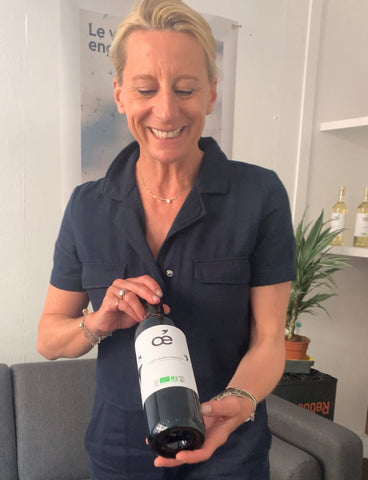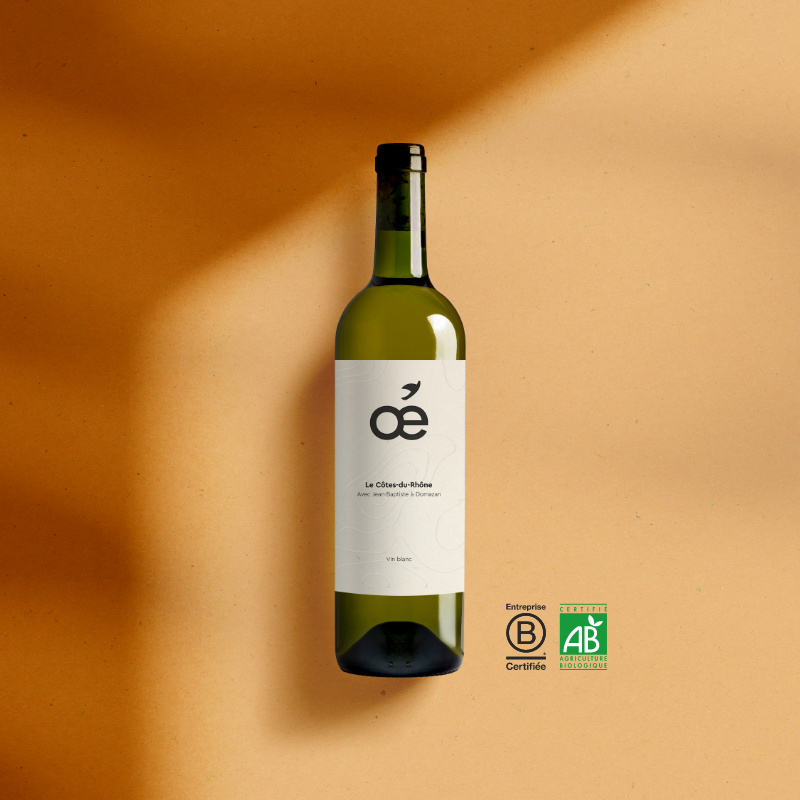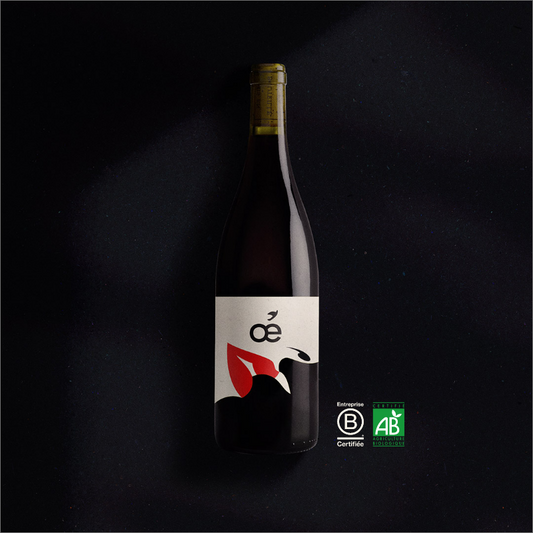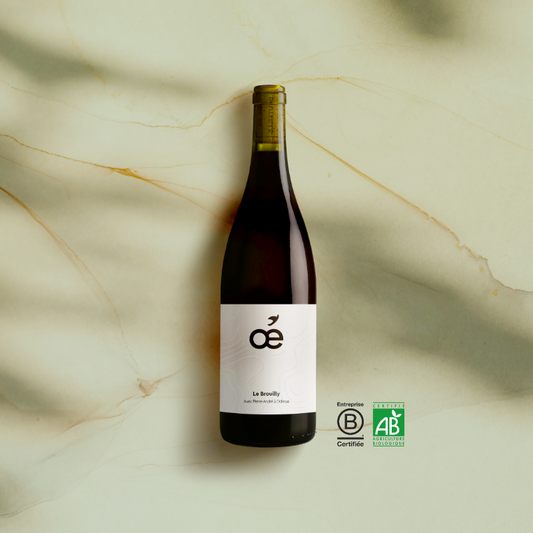Oh, oh! We have a surprise to announce: the new cuvée of Saint-Émilion Grand Cru has arrived on our site! To offer you this delicious committed bottle, we work hand in hand with Valérie and Alexis, Oé winegrowers not far from Bordeaux, in Saint-Émilion. You want to know more ? Let's go !
I discover the Saint-Émilion Grand Cru
The characteristics of Saint-Émilion Grand Cru


The Saint-Émilion Grand Cru is an exceptional wine that can be enjoyed on your special occasions. It is a wine of pleasure that will delight your taste buds during your meals with the family or with your loved ones around grilled vegetables a la plancha and beautiful mixed salads. It is supple and round in the mouth.
I order my Saint-Émilion Grand Cru

Meet Valérie and Alexis, Oé winegrowers in Saint-Émilion
Can you tell us about the history of the estate?
“There is no story, strictly speaking, rather a crush on this unique environment. And if we add the magic of both the wine and the appellation… unstoppable.”
How long have you been organic?
“We have been certified since the 2013 vintage and began our process in good conscience in 2010. Despite the challenges, we are continuing with our approach, which is just as much a philosophy. We naturally continued towards the HVE standard. As in biodynamics, we seek on a daily basis the harmonious balance between the land, the vine, the soil and our work as winegrowers.”
What challenges do you encounter in the vineyard?
“The biggest challenge is to harvest grapes in an irreproachable state of health to produce the best expression of our terroir. Every year we race against time with the vines to contain the infernal trio: mildew, powdery mildew, botrytis (those fungal diseases that are difficult to control). It's a long-term marathon between tillage, grassing, treatments (at a minimum) under the benevolent influence (or not) of the vagaries of ocean weather. Anticipating, managing, adapting, balancing, persevering: surpassing oneself every year thanks to passion is the secret.”
How is the winemaking process in your domain?
“After sorting by density (selection of mature and healthy grapes according to their natural weight), we work in the traditional way (in Bordeaux) by crushing, regular but delicate pumping over to “extract” the tannins and coloring matter from the wine. We add, when and if necessary, organic yeasts (to avoid deviations at the beginning of the 1st fermentation ) and a light sulphiting to protect the future wine and always according to the regulatory constraints of our certifying body.
Then follows the alcoholic fermentation between 7 and 10 days depending on the vintage, then a pressing after 3 weeks; with tasting and analytical monitoring throughout the transformation process.
Then finally (approx. 2 months) barreling in oak barrels (French because they are suitable for our wine) from several coopers, some of which are from Burgundy and depending on the vintage 30 to 45% are new, then 1/3 of barrels having contained 1 wine and a 1/3 of barrels having contained 2 wines. The wine will then be aged between 14 and 18 months depending on the quality of the vintage.”
With which dishes to pair Saint-Émilion?
“A barbecued rib of beef, lamb (in all its forms) as a leg, rack or shoulder, in a stew, with parsley butter in the oven, with string, in chops accompanied by a sauce with garlic and thyme, tomato and basil, cumin, casserole, marinated on skewers, glazed with orange, in a crust, with herbs… Duck aiguillettes with honey! And for vegetarians, grilled vegetables a la plancha with rice infused with thyme and rosemary. A delight!”
What are the causes that are most important to you?
“There are so many beautiful and noble causes to defend, but as far as we are concerned, the preservation of nature, which alone conditions the well-being of humanity, mistreatment, poverty and hunger in the world.”
How to respond to copper and sulfur attacks?
“For the moment, no alternative in effective biological control has been found to completely replace the use of copper. Copper remains today in organic viticulture, a pillar of the fight against mildew and the only natural active ingredient that is really effective against this fungus. If its repeated (and excessive) use in the last century has had a demonstrated impact on the soil and the environment, today we are in the era of dose restriction and reasoning to limit its accumulation in the environment. As in all areas of life, it is INTENSIVE use that is harmful to life.
At the request of renowned wine estates, a summary made by scientists (based on reports already established) reported " the impossibility of objectively concluding on any impact of copper on soil life for a dose of 4 kg of copper / ha / year ”. Better still, the soils were only impacted “ from acute exposure (200 kg/ha), i.e. 50 times the limit dose set by Europe ”.
What is certain is that if necessary we must be able to use an "antibiotic" medicine as we do when we have angina or sometimes a simple flu for convenience. The real problem is the impact of this antibiotic medicine: if it is neutral, why can't we use it? But with it also this complication: what is its harmlessness on the environment and the vines; difficulty in every way equivalent to the questions we ask ourselves for ourselves and our children.
It should also be borne in mind that in an oceanic climate with mild temperatures and abundant rainfall without copper and sulfur treatment, we could not harvest. It is therefore not just the grapes that would be impacted, but an entire agricultural sector that is just waiting to make a living from its most eco-responsible activity possible.
We all want balanced management between us humans and nature but we cannot, reasonably speaking, change everything overnight. For our part, working for a better organic soil life, preventing, anticipating and seeking new, innovative methods and sustainable alternatives are the paths we are following.
As far as sulfur is concerned, do you know that it is the 3rd constituent element of the human body (the 5th of the plant); it is in fact essential to the proper functioning of living beings. For the vine, sulfur is considered a trace element, it is one of the elements necessary for the nutrition of the plant. The inputs in the context of phytosanitary protection largely cover the needs of the plant. We use so-called biocontrol products, which are defined as a set of means of crop protection based on the use of living organisms or natural substances.
But each product has, as with drugs, undesirable and side effects that we must strive to limit; we will not be able to eradicate them unless we no longer want any possible life on earth. You have to find the right balance.”






